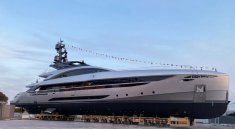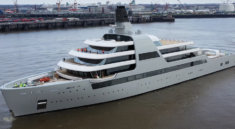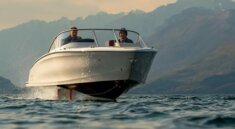All visitors to the site of the famous shipbuilder Riva are greeted with a proud inscription "A new era of design" ("New era in design"). And this is not an exaggeration at all.
The company's history is based on the legend of how a young ship's carpenter, Pietro Riva, set about rebuilding a fishing fleet that had been badly damaged after a storm that hit Lake Iseo in northern Italy in 1842. Moreover, he was not just engaged in repairs, but put his whole soul into this business, gaining the respect and admiration of local residents. And after the restoration work was completed, Riva set about starting his own business and setting up the production of boats of his own design. Thus was born a company that was destined to become legendary in the end. It was in the small town of Sarnico, located on the shores of the aforementioned lake, where to this day the headquarters of Riva is located.
The products of the young manufacturer quickly became popular due to their thoughtful design and reliability. But the real success came to the company after the First World War, when it was decided to abandon transport ships and begin the production of small speed boats, which were still a novelty at that time, but had already come to the liking of wealthy consumers. By the early 1930s, Riva racing yachts had already won countless awards and set various records in national and international competitions. In the 50s, the brand became not only well-known, but very popular, many celebrities willingly purchased its products. Famous clients included the Shah of Iran, Brigitte Bardot, Sophia Loren, Peter Sellers and many others.
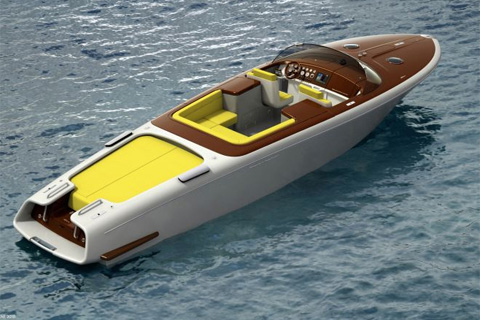
By that time, the company was headed by Carlo Riva, a descendant of an enterprising carpenter. He understood the importance of design and devoted a lot of time to this issue, creating himself and actively collaborating with many famous designers of those years. And in November 1962, a legend was born - a small sports and pleasure boat (runabout) Aquarama, which immediately became a classic, a kind of symbol of Riva, a brand within a brand. Some journalists even dubbed this model the "Ferrari of the Boat World". This twin-engine creation with a folding roof was capable of speeds up to 50 knots (top version). The original Aquarama was produced until 1972, with a total of 281 units built. Other, somewhat revised versions followed.
Another historical milestone for the company is considered to be 1969, when it began to manufacture ships from fiberglass, instead of traditional wood. Riva's first two composite models were the Bahia Mar 20' and Sport Fisherman 25' cruisers. However, despite the victorious march of plastic, Riva continued to work with wood for some time. All the “descendants” of Aquarama were wooden, up to the Aquarama Special, the production of which ended in 1996.
In the late 60s, Carlo Riva sold the company to the American concern Whittaker in September 1969, although he remained as chairman and CEO. Then the shipyard changed owners several more times. In 1989, she moved to the British group Vicker and the Reeve family has had no connection with her since. Riva has been owned by the Italian shipbuilding company Ferretti Group since 1999.
However, all these ups and downs with the change of owners did not affect either the quality or the spirit of the famous brand. And a great example of the Riva's highest level is the boat designed in collaboration with renowned industrial designer Marc Newson and design company Officina Italiana Design. We are talking, of course, about Aquariva by Marc Newson, presented in 2010.
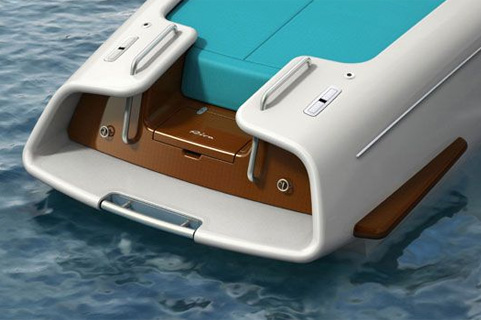
Even a cursory glance at this ship is enough to understand that we have before us the creation of Riva, endowed with the spirit of Aquarama. But at the same time, Mark Newson managed to create something original, able to win the hearts of even very demanding consumers. However, not everyone will be able to get such a “toy”, because only 22 units of Aquariva by Marc Newson are planned to be released. But the limited series only added interest to the great new product.
It is interesting that an unusual material was used to create the boat - a phenolic composite created in the first half of the 20th century (it should be noted that Newson has repeatedly resorted to the use of this substance). It resembles a tree, but much more reliable than it. Also, instead of much more traditional stainless steel, the designer also used anodized aluminum rarely used in shipbuilding, the purpose of which is to make the vessel more stylish and modern.
The latest technology was used in the creation of a unique vessel, while much attention was paid to simplicity and functionality. The 10-meter boat with a caddy cabin, capable of accelerating to 41 knots, received a one-piece rounded windshield, once again emphasizing its swift forms and an unusually shaped transom. Customers were offered a variety of color options - from simple white to bright turquoise. There is enough space on board for 8 people.
But one should not think that Riva is only capable of making small sports boats great. For example, the 28m motor yacht Riva 90′ Argo, launched in 2017, is an example of a great vessel capable of sailing on the open sea and reaching a speed of 26 knots. Even more impressive is the 50m Riva 50′ Metri, with a top speed of 16 knots, built around the concept of “totally immersed in the sea and living in the open air”. All this is a worthy successor to the magnificent steel motor yachts of the Caravelle and Atlantic series, on which Carlo Riva worked in the 60s and 70s of the last century.

